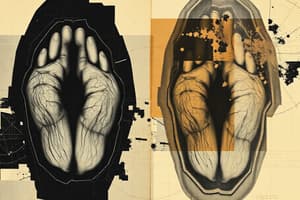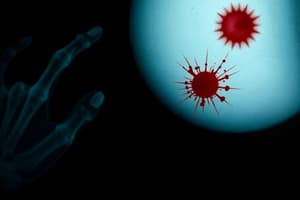Podcast
Questions and Answers
Flashcards
Entrance Gunshot Wound
Entrance Gunshot Wound
A type of gunshot wound that shows an outward beveling of tissue. This means that the bullet's exit wound is larger than its entry wound.
Preserving Clothing with Bullet Holes
Preserving Clothing with Bullet Holes
A method used to preserve a bullet hole in clothing for forensic analysis . It involves carefully removing the clothing around the hole without folding or creasing the fabric.
Paraffin Test
Paraffin Test
This test is used to detect the presence of gunpowder residue on a person's hands. A positive test involves the presence of blue flecks, indicating nitrates from gunpowder.
Low Explosive
Low Explosive
Signup and view all the flashcards
Saltpeter in Gunpowder
Saltpeter in Gunpowder
Signup and view all the flashcards
Primary Purposes of Cartridges
Primary Purposes of Cartridges
Signup and view all the flashcards
Cartridge Parts
Cartridge Parts
Signup and view all the flashcards
Gunpowder
Gunpowder
Signup and view all the flashcards
Multi-Perforated Grains
Multi-Perforated Grains
Signup and view all the flashcards
Armor-Piercing Bullet
Armor-Piercing Bullet
Signup and view all the flashcards
Exploding Bullet
Exploding Bullet
Signup and view all the flashcards
Priming Mixture
Priming Mixture
Signup and view all the flashcards
Centerfire Cartridge
Centerfire Cartridge
Signup and view all the flashcards
Cartridge Case Markings
Cartridge Case Markings
Signup and view all the flashcards
Lead Bullet
Lead Bullet
Signup and view all the flashcards
Incendiary Bullet
Incendiary Bullet
Signup and view all the flashcards
Striations on a Bullet
Striations on a Bullet
Signup and view all the flashcards
Caliber
Caliber
Signup and view all the flashcards
Fluted Bullet
Fluted Bullet
Signup and view all the flashcards
Extractor Mark
Extractor Mark
Signup and view all the flashcards
Jacketed Bullet
Jacketed Bullet
Signup and view all the flashcards
Frangible Bullet
Frangible Bullet
Signup and view all the flashcards
Pistol Cartridge Markings
Pistol Cartridge Markings
Signup and view all the flashcards
Methodology of Firearm Examination
Methodology of Firearm Examination
Signup and view all the flashcards
High Explosive
High Explosive
Signup and view all the flashcards
Tracer Bullet
Tracer Bullet
Signup and view all the flashcards
Firearm/Toolmark Identification
Firearm/Toolmark Identification
Signup and view all the flashcards
Shoulder Firearm
Shoulder Firearm
Signup and view all the flashcards
Muzzle Energy
Muzzle Energy
Signup and view all the flashcards
Study Notes
Gunshot Wounds
- Entrance gunshot wounds typically have an abrasion rim, tissue invagination, and outward beveling of the tissue. Smaller wounds may also be present.
- When preserving clothing with alleged bullet holes, do not fold the clothing. Carefully remove the cloth and allow it to dry. Put the clothing in a plastic bag.
Gunpowder Analysis
- Gunpowder residue can be detected in paraffin. Brown and blue flecks can be indicators of gunpowder.
- Materials designed to deflagrate or burn rather than explode are categorized as low explosives.
Cartridge Characteristics
-
Cartridges are designed to be a convenient, pre-assembled package and for easy handling and transportation.
-
Cartridge cases (the part of the cartridge that contains the primer, propellant, and projectile), have specific features, like a bottleneck, case neck, case body, case shoulder, and straight walls
-
These components can be identified and compared to other cartridge components to assist in investigations
Bullet Characteristics
- Specialized bullets, like tracer bullets, have specific characteristics.
- Bullets designed for explosive or incendiary purposes are also identified for their distinct composition, to assist in investigations
Marks on Firing Cartridge Cases
- Fired (and unfired) cartridge cases often have unique marks that are unique to the specific firearm.
- Examples of marks on cartridge cases include: impressed action marks (such as extractor marks, breech marks, and firing pin impressions), striated motion marks and ejector marks.
Studying That Suits You
Use AI to generate personalized quizzes and flashcards to suit your learning preferences.




